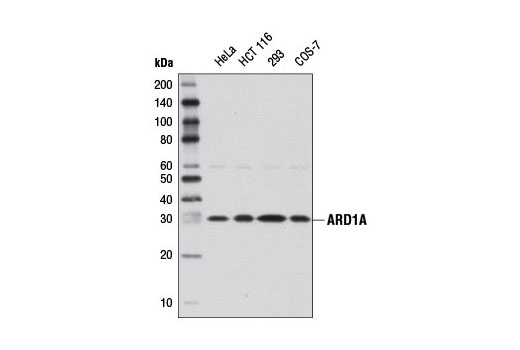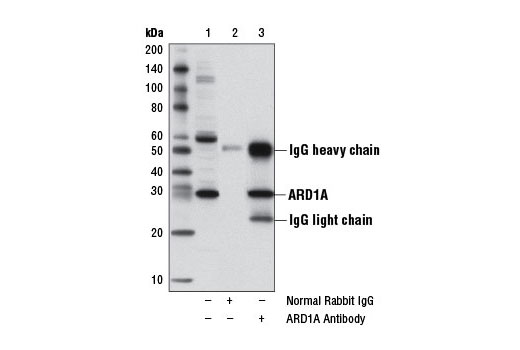WB, IP
H Mk
Endogenous
28
Rabbit
#P41227
8260
Product Information
Product Usage Information
| Application | Dilution |
|---|---|
| Western Blotting | 1:1000 |
| Immunoprecipitation | 1:50 |
Storage
Specificity / Sensitivity
Species Reactivity:
Human, Monkey
Source / Purification
Polyclonal antibodies are produced by immunizing animals with a synthetic peptide corresponding to residues surrounding Val171 of human ARD1A protein. Antibodies are purified by protein A and peptide affinity chromatography.
Background
Protein acetylation is a common modification that occurs both at lysine residues within proteins (ε-amino acetylation) and multiple amino acid residues at the amino terminus of proteins (α-amino acetylation). The N-α-acetyltransferase ARD1 homolog A protein (ARD1A, also known as NAA10) and the highly homologous N-α-acetyltransferase ARD1 homolog B protein (ARD1B, also known as ARD2 or NAA11) are mutually exclusive catalytic subunits of the amino-terminal acetyltransferase complex (NatA) (1-3). This complex, which consists of either ARD1A or ARD1B and the N-α-acetyltransferase 15 (NAA15) auxiliary protein, localizes to ribosomes where it functions to acetylate Ser-, Ala-, Gly-, Thr-, Cys-, Pro-, and Val- amino termini after initiator methionine cleavage during protein translation (1-5). Like ε-amino acetylation, amino-terminal α-amino acetylation functions to regulate protein stability, activity, cellular localization, and protein-protein interactions (4,5). Defects in ARD1A have been shown to cause amino-terminal acetyltransferase deficiency (NATD), which results in severe delays and defects in postnatal growth (6).
In addition to functioning as amino-terminal acetyltransferases in the NatA complex, free ARD1A and ARD1B proteins regulate cell growth and differentiation through ε-amino acetylation of lysine residues in multiple target proteins, including the HIF-1α, β-catenin, and AP-1 transcription factors (7-9). ARD1A-mediated acetylation of HIF-1α at Lys532 under normoxic conditions enhances binding of VHL, leading to increased ubiquitination and degradation of HIF-1α and down-regulation of HIF-1α target genes involved in angiogenesis, apoptosis, cellular proliferation, and glucose metabolism (7). Decreased expression of ARD1A under hypoxic conditions contributes to the stabilization of HIF-1α and upregulation of target genes (7). ARD1A also promotes cell proliferation and tumorigenesis by acetylating and activating β-catenin and AP-1 transcription factors, leading to the stimulation of cyclin D1 expression (8,9). Interestingly, the acetyltransferase activity of ARD1A is regulated by autoacetylation at Lys136, which is required for the ability of ARD1A to promote proliferation and tumorigenesis (9). Research studies have shown that ARD1 proteins are over-expressed in multiple cancers, including breast, prostate, lung, and colorectal cancers (10-13).
- Arnesen, T. et al. (2005) Biochem J 386, 433-43.
- Arnesen, T. et al. (2006) BMC Biochem 7, 13.
- Pang, A.L. et al. (2009) Biol Reprod 81, 302-9.
- Van Damme, P. et al. (2011) FEBS J 278, 3822-34.
- Polevoda, B. and Sherman, F. (2000) J Biol Chem 275, 36479-82.
- Rope, A.F. et al. (2011) Am J Hum Genet 89, 28-43.
- Jeong, J.W. et al. (2002) Cell 111, 709-20.
- Lim, J.H. et al. (2006) Cancer Res 66, 10677-82.
- Seo, J.H. et al. (2010) Cancer Res 70, 4422-32.
- Arnesen, T. et al. (2005) Thyroid 15, 1131-6.
- Ren, T. et al. (2008) Cancer Lett 264, 83-92.
- Yu, M. et al. (2009) Oncol Rep 21, 909-15.
- Yu, M. et al. (2009) Cancer Invest 27, 978-83.
Species Reactivity
Species reactivity is determined by testing in at least one approved application (e.g., western blot).
Western Blot Buffer
IMPORTANT: For western blots, incubate membrane with diluted primary antibody in 5% w/v BSA, 1X TBS, 0.1% Tween® 20 at 4°C with gentle shaking, overnight.
Applications Key
WB: Western Blotting IP: Immunoprecipitation
Cross-Reactivity Key
H: human M: mouse R: rat Hm: hamster Mk: monkey Vir: virus Mi: mink C: chicken Dm: D. melanogaster X: Xenopus Z: zebrafish B: bovine Dg: dog Pg: pig Sc: S. cerevisiae Ce: C. elegans Hr: horse GP: Guinea Pig Rab: rabbit All: all species expected
Trademarks and Patents
使用に関する制限
法的な権限を与えられたCSTの担当者が署名した書面によって別途明示的に合意された場合を除き、 CST、その関連会社または代理店が提供する製品には以下の条件が適用されます。お客様が定める条件でここに定められた条件に含まれるものを超えるもの、 または、ここに定められた条件と異なるものは、法的な権限を与えられたCSTの担当者が別途書面にて受諾した場合を除き、拒絶され、 いかなる効力も効果も有しません。
研究専用 (For Research Use Only) またはこれに類似する表示がされた製品は、 いかなる目的についても FDA または外国もしくは国内のその他の規制機関により承認、認可または許可を受けていません。 お客様は製品を診断もしくは治療目的で使用してはならず、また、製品に表示された内容に違反する方法で使用してはなりません。 CST が販売または使用許諾する製品は、エンドユーザーであるお客様に対し、使途を研究および開発のみに限定して提供されるものです。 診断、予防もしくは治療目的で製品を使用することまたは製品を再販売 (単独であるか他の製品等の一部であるかを問いません) もしくはその他の商業的利用の目的で購入することについては、CST から別途許諾を得る必要があります。 お客様は以下の事項を遵守しなければなりません。(a) CST の製品 (単独であるか他の資材と一緒であるかを問いません) を販売、使用許諾、貸与、寄付もしくはその他の態様で第三者に譲渡したり使用させたりしてはなりません。また、商用の製品を製造するために CST の製品を使用してはなりません。(b) 複製、改変、リバースエンジニアリング、逆コンパイル、 分解または他の方法により製品の構造または技術を解明しようとしてはなりません。また、 CST の製品またはサービスと競合する製品またはサービスを開発する目的で CST の製品を使用してはなりません。(c) CST の製品の商標、商号、ロゴ、特許または著作権に関する通知または表示を除去したり改変したりしてはなりません。(d) CST の製品をCST 製品販売条件(CST’s Product Terms of Sale) および該当する書面のみに従って使用しなければなりません。(e) CST の製品に関連してお客様が使用する第三者の製品またはサービスに関する使用許諾条件、 サービス提供条件またはこれに類する合意事項を遵守しなければなりません。

